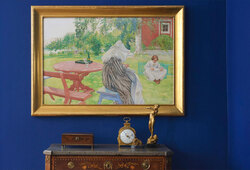New Season – New Highlights: "Church Window" by Helene Schjerfbeck
Helene Schjerfbeck, "Church Window"
Helene Schjerfbeck's painting "Church Window" from 1919 stands as one of the artist's most captivating urban landscapes. The subject is the side window of the Ekenäs church and the branching tree trunk nearby. Similar to Schjerfbeck's portraits, this is not a mere depiction but an expression of a soulful state. From a distance, the painting almost presents an abstract impression, akin to the Japanese notion of images that appear as if viewed through a keyhole. One is drawn to the undulating forms and intertwining colors, accentuated by the clear blue sky at the upper right corner.
Schjerfbeck visited her ancestors' town of Ekenäs during the years 1918, 1919, and 1920, settling there permanently in 1925. The summers of 1918 and 1919 brought her many joyful moments but also profound disappointments.
In its composition, "Church Window" is in many ways an avant-garde painting. Helene Schjerfbeck was ahead of her time, as evidenced by her painting of the door to Trémalos Chapel in Pont-Aven in 1894. Once again, in "The Church Window," she demonstrates her ability to paint space two-dimensionally while emphasizing that the subject depicts a place. This was considered avant-garde at the time, as Western artists had been indoctrinated since the Renaissance about the superiority of perspective's illusion. The subject is intricately linked to the artist's emotional state and reflects her longing for closeness, despite her need to protect her psyche due to her hypersensitivity.
"Church Window" transcends mere urban scenery; it expresses a mental landscape that envelops the viewer in a gentle embrace.
Text: Leena Ahtola-Moorhouse

"Church Window" by Helene Schjerfbeck is one of the many highlights being sold at Bukowskis' online auction, Helsinki Spring Sale, taking place from May 17th to May 29th. For more information and condition reports, please get in touch with Bukowskis' Head Specialist in Finnish Art, Johan Wulff: johan.wulff@bukowskis.com, +358 (0)50 410 1377.
To the catalogue

Requests & condition reports Contact specialist

























